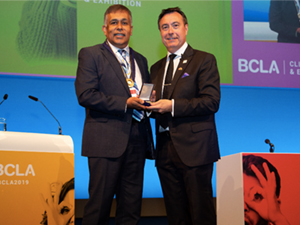| 
|
| Lyndon Jones (r) receives the BCLA Medal from BCLA president Sunil Shah at the association’s clinical conference and exhibition in Manchester, England.
|
| |
In terms of news-making events, it’s been a busy 2019 for the contact lens sector of eyecare. Shortly after the year began, Alcon once again became an independent company (following its spinoff from Novartis) and Johnson and Johnson debuted Acuvue Oasys with Transitions lenses, a first-of-its-kind contact lens that can sense lighting conditions.
In the summer, Bausch + Lomb launched the Ultra Multifocal for Astigmatism contact lens, the first and only multifocal toric lens available as a standard offering in the ECP’s fit set, and Alcon introduced its Precision1 lens, which the company said is the first “mainstream daily disposable contact lens to use SmartSurface technology.”
In addition, the FDA in August approved
Paragon Vision Science's newly constructed contact lens manufackturing site in suburban Phoenix, which the company said would "pave the way for the company’s ongoing domestic and global expansion." Paragon is part of the CooperVision Specialty EyeCare group. And in June, Cooper Companies (parent of CooperVision) announced its alignment with the United Nations Sustainable Development Goals (SDGs), a global framework and action plan to end poverty, protect the planet and ensure prosperity and peace for all by 2030.
But researchers seeking further advancements in contact lenses are busy pursuing the next new thing that will upend the category, including the development and commercialization of drug-delivering lenses. One of the experts most knowledgeable in this area of research is Dr. Lyndon Jones, PhD, DSc, FCOptom, FAAO, FBCLA, and director of the Centre for Ocular Research & Education (CORE) in Waterloo, Ontario.
Jones, who was the recipient of the prestigious British Contact Lens Association’s (BCLA) 2019 Medal, spoke with VMAIL Weekend recently on a wide range of CL topics, including the development of drug-delivering lenses. (The BCLA Clinical Conference & Exhibition was held earlier this summer in Manchester, England, and attracted more than 1,000 eyecare professionals from around the world.)
One of the conference highlights was the keynote address by Jones, whose talk reflected on his research experiences over the past three decades. One of the areas of research in which Jones has been actively involved is the effort to determine whether contact lens materials can be developed to successfully deliver prescription drugs to the ocular surface of a patient. (He’s also been involved in research related to corneal staining and the control of contact lens deposits.)
The idea of delivering drugs via soft contact lens materials actually dates to a 1961 patent, he noted. “Here we are, all those years later, and there’s still nothing commercially available on the market,” he said. However, he noted that Johnson & Johnson Vision has stated in publically available research papers that it is developing an antihistamine releasing soft contact lens and hopes to have an approved lens available sometime in the near future.
J&J has reported phase 3 data from two clinical studies of the antihistamine-releasing contact lens, which demonstrated that the lens was able to reduce feelings of itchy eyes after exposure to allergens. The soft, disposable contacts in the trial are made of etafilcon A—which is used for many Acuvue daily-wear lenses—and were combined with a small amount of the antihistamine ketotifen, the active ingredient in Alcon’s Zaditor anti-allergy eyedrops, according to reports on the trials.
“I think this [a drug-delivery contact lens] will happen, and I don’t think there is any doubt about the fact that we will start to see drug-delivering lenses,” he said. He noted that there have been about 350 papers published on the topic of ocular drug delivery and that more than two-thirds of these papers have been published in the past decade.
“There are now a fair number of groups around the world looking at developing materials that will do that, including delivering a wide variety of drugs to the ocular surface,” he said. “I do think that probably the one that J&J has landed on, an anti-allergy [therapy], is probably one of the easiest ones to go for.”
Other developers are looking at treating glaucoma, which would be a significant development because of the high rates of non-compliance to treatment among patients with glaucoma, and perhaps even the delivery of antibiotics, which is a more difficult method to tackle.

|
|
Lyndon Jones
|
|
| | |
Jones, who has published many papers on this topic, said the advent of nanotechnologies has sped up this area of research because this has helped in the development of materials that control “with fairly good accuracy” the drug delivery process. “You can actually get lens materials to take up drugs pretty easily,” he said. “But the problem always has been delivering them at a sufficiently slow rate” so that it is therapeutically relevant.
He said he believes commercialization of these lenses is “further out, but still definitely going to happen” and that once J&J markets its antihistamine lens, other companies will be in position to bring new products to the market for treating ocular diseases, also. Other areas of research are dry eye, cancer and glaucoma, and even whether contact lenses can be used to measure blood pressure.
Further out is the possibility of using contact lenses in the area of facial recognition, he said.
Still, one of the challenges to these development efforts, he said, there are regulatory hurdles around the clinical trial process and data collection that have to be overcome. Another challenge is that there are many countries around the world in which optometrists are not permitted to dispense topical ocular drugs, with the exception of North America, Australia and some areas of Europe. Jones said he expects there will be a number of challenges to bring the new lenses to the market once they are available.
He added, “There are a ton of really good contact lens products on the market already. [But] I think practitioners are really quite poor at trying to recommend contact lenses to their patients. They are far too complacent and they sit there waiting for their patients to ask for a contact lens trial, as opposed to being more pro-active and proposing to their patients that they would see a benefit from wearing contact lenses that are already here.”
Caption:
Lyndon Jones (r) receives the BCLA Medal from BCLA president Sunil Shah at the association’s clinical conference and exhibition in Manchester, England.